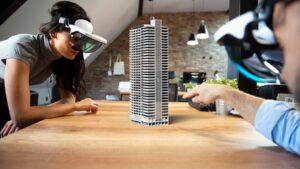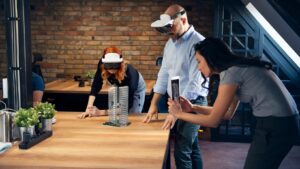Stepping into the future of construction, I’ve witnessed the transformative power of augmented reality (AR) in reshaping the industry. With AR technology, construction projects are no longer confined to blueprints on paper; they come to life in three-dimensional, interactive models that revolutionize the way we build. From visualizing complex designs to enhancing on-site productivity, AR is paving the way for a new era of efficiency and precision in construction.
In my experience, integrating AR into construction processes has proven to streamline workflows, reduce errors, and accelerate project timelines. By overlaying digital information onto the physical environment, construction teams can visualize structures before they’re even built, making real-time adjustments and ensuring optimal outcomes.
Augmented Reality Construction
The Basics of Augmented Reality Technology
Augmented Reality (AR) technology enhances the real world by overlaying digital information, such as 3D models and data, onto physical environments in real-time. It blends virtual elements with the existing surroundings, providing users with an interactive and immersive experience. AR operates through devices like smartphones, tablets, and specialized AR headsets, offering a unique perspective that enriches user interactions with the physical world. This technology’s ability to superimpose digital content onto real-world settings revolutionizes how information is visualized, accessed, and manipulated in various industries, including construction.
Applications of AR in the Construction Industry

In the construction industry, Augmented Reality (AR) brings significant benefits and innovations that improve project planning, design, and execution processes. Construction professionals use AR to visualize complex architectural designs in 3D, allowing for better communication and understanding of project requirements. AR facilitates on-site coordination by overlaying digital models onto physical structures, enabling teams to detect potential clashes and make real-time adjustments. Moreover, AR assists in project management tasks, such as progress tracking, quality control inspections, and safety assessments, enhancing overall operational efficiency and productivity. The integration of AR technologies in construction leads to streamlined workflows, reduced errors, and accelerated project timelines, ultimately optimizing outcomes and driving advancements in the industry.
Key Benefits of Augmented Reality Construction
Enhancing Project Visualization
Augmented reality in construction allows me to visualize projects more effectively by overlaying digital information onto the physical environment in real-time. It enables me to see 3D models superimposed onto the actual construction site, providing a clear understanding of the project’s scale, design, and layout. This transformative visualization capability helps me make more informed decisions during the planning and execution stages, leading to improved project outcomes and reduced errors.
Improving Accuracy and Efficiency
With augmented reality technology, I can enhance the accuracy and efficiency of construction projects significantly. By using AR tools, I can detect clashes between design elements and existing structures in real-time, allowing me to address issues promptly and avoid costly rework. This proactive approach to problem-solving not only increases the precision of construction activities but also boosts overall productivity by streamlining workflows and minimizing errors throughout the project lifecycle.
Streamlining Collaboration and Communication

Augmented reality construction facilitates seamless collaboration and communication among project stakeholders. I can share 3D models and project data with team members in a visually engaging and interactive manner, promoting better understanding and alignment on project goals. By offering a shared view of the project through AR, communication barriers are reduced, leading to improved coordination, quicker decision-making, and ultimately, enhanced project outcomes.
Challenges and Limitations
Technical Hurdles and Equipment Cost
In the realm of augmented reality construction, one of the primary challenges is overcoming technical obstacles and managing the substantial costs associated with the required equipment. Implementing AR technology demands robust devices capable of processing complex 3D models in real-time, which can strain existing hardware capabilities.
Training and Adaptation for Workforces
Another significant limitation in the adoption of augmented reality in construction is the need for extensive training and workforce adaptation. Integrating AR tools into daily operations requires upskilling workers to effectively utilize these technologies. Training programs must be comprehensive and ongoing to ensure all team members are proficient in operating AR devices and interpreting the information displayed. Additionally, adapting workflows to incorporate AR functionalities may disrupt traditional processes, requiring a cultural shift within the workforce towards a tech-savvy and digitally integrated approach to construction.

